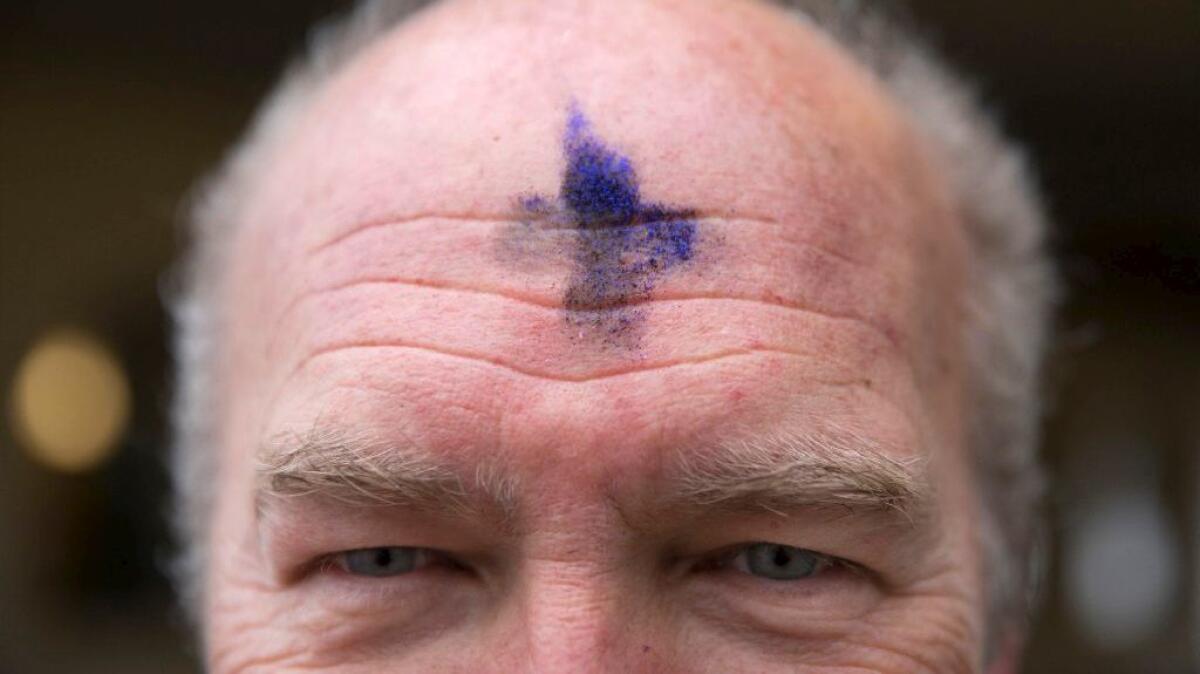How some are using glitter on Ash Wednesday as a shout-out to the LGBTQ community

- Share via
For 30 years as an Episcopal priest in Iowa, Peter Sickels smeared crosses of ash on the foreheads of his parishioners every Ash Wednesday.
“Remember, oh man,” he would say during the ceremony marking the start of Lent, “you are dust and to dust you shall return.”
But this year, his ash has an extra ingredient: purple glitter.
Sickels, now retired and living in San Diego, is one of roughly 150 religious leaders across the country who left parishioners with some sparkle to show support for the LGBTQ community.
“I love the concept of not just ashes but glitter for new hope and new life, and just standing up for minorities, for those who are incredibly in distress at these times,” Sickels said.
Others were less enthused with modifying a 1,500-year-old tradition.
“However well-intentioned, Glitter Ash Wednesday is a distraction at best and a sideshow at worst,” wrote Jacob Lupfer, a columnist for Religion News Service. “I find it hard to believe pastors and churches that have already evolved on sexual ethics will tamper with the tradition, solemnity and dignity of Ash Wednesday.”
The idea stretches back to Ash Wednesday of last year, when Liz Edman, an Episcopal priest in New Jersey, wished for a way to “come out” as visibly queer and visibly Christian. She set her phone alarm to ring the following January to remind her of the thought.
When her girlfriend later mentioned glitter, Edman was initially guarded.
“It matters very much to me that people understand we’re not doing this in order to be frivolous or disrespectful,” she said. “Glitter is serious business for queer people. Glitter is how we have long made ourselves visible, even though becoming visible puts us at risk.”
But then, she said, she came across St. Augustine’s teachings warning of the dangers of despair, which could thwart repentance and change.
“I just thought, ‘Bingo, that’s it,’” she said. “The glitter can represent a refusal to bow down to the forces of despair, particularly in this political moment we find ourselves in.”
The message spread through social media, and according to organizers, 150 religious figures — representing Lutheran, Presbyterian and Old Catholic churches, among others — expressed interest. Ash Wednesday, a Roman Catholic tradition, has been embraced in recent decades by other denominations.
Marian Edmonds-Allen, a Protestant minister and the executive director of the faith-based LGBTQ organization Parity, mixed and shipped enough glitter and ash for 15,000 people in 29 states and three countries.
“Ash Wednesday is a time when people think about their mortality,” she said. “The addition of glitter to that solemn ritual represents the joy and the hope that we feel.”

alene.tchekmedyian@latimes.com
Follow me on Twitter @AleneTchek
More to Read
Sign up for Essential California
The most important California stories and recommendations in your inbox every morning.
You may occasionally receive promotional content from the Los Angeles Times.














